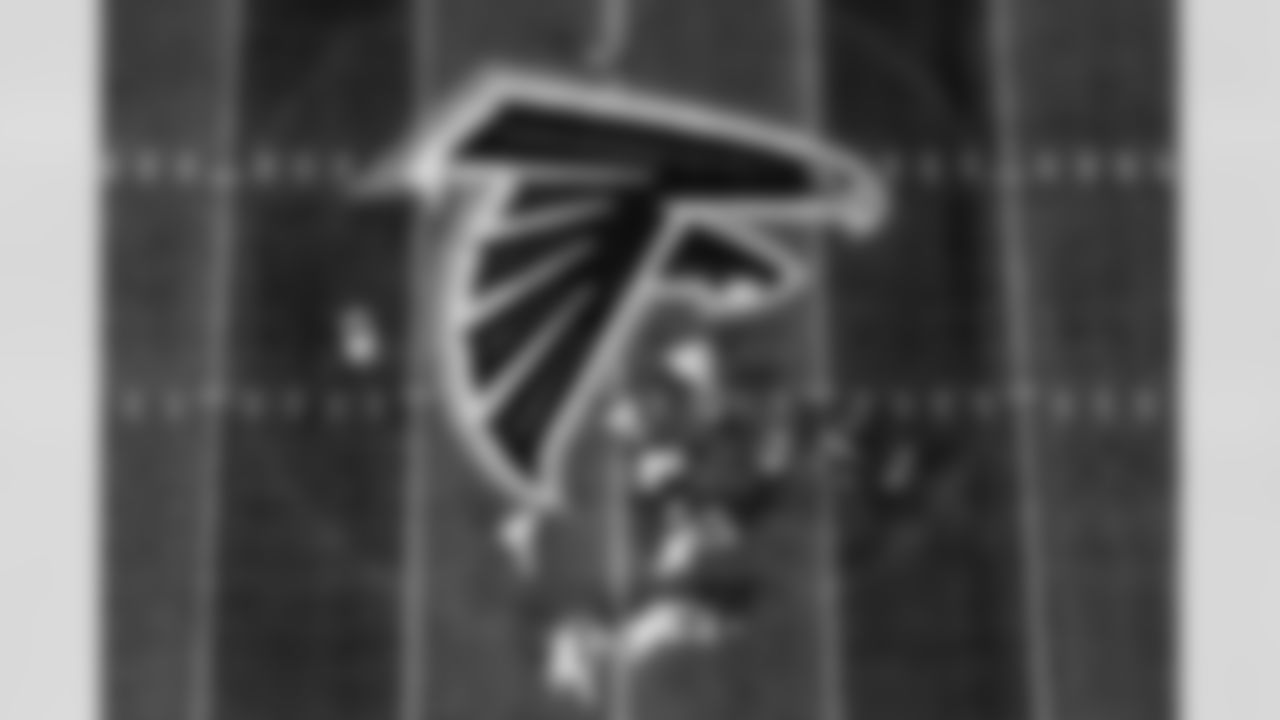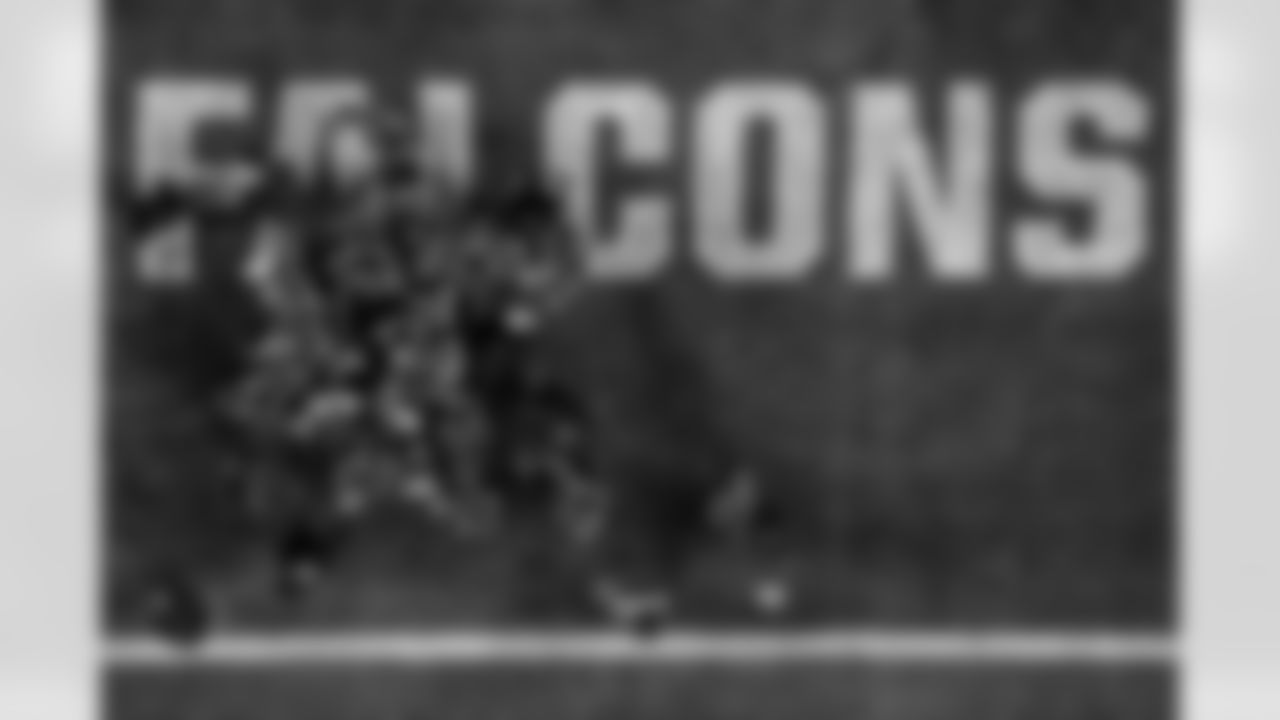Editor's note: This is the first installment of a three-part series focusing on how the Falcons proceed through free agency. We open things up with a look at how the Falcons got right with the salary cap in just two years, creating a level of financial flexibility not experienced in Atlanta in some time.
For many, buying your first brand new car is a luxury, a success and a process that often requires months (if not years) of work. You save the money. You cut back on expenses. You wait and wait until the funds are there for you to drive to the dealership to make a deal.
You've done your research. You know what you're looking for. You await its availability for a test drive. You know your price point. You hope they negotiate with you. Ultimately, you plan to drive that car off the lot the moment you purchase it, reaping the benefits of a plan seen all the way through. You relish in the opportunity to finally put miles on it.
For Kirsten Grohs – the manager of football administration for the Falcons – this is the analogy she'd use to describe where Atlanta finds itself with the start of the new league year a week away.
RELATED CONTENT:
- The art of the interview: Terry Fontenot provides a look inside inside the Falcons formal interview process at the 2023 NFL combine
- Draft analysis: Could the Falcons' play at No. 8 be to take a cornerback like Christian Gonzalez, Joey Porter?
- Why Lukas Van Ness, Myles Murphy, Tyree Wilson could be great options for Falcons at No. 8 overall in 2023 NFL Draft
- Bair: Why discipline is essential for Terry Fontenot, Arthur Smith to execute Falcons offseason plan well
On March 15 at 4 p.m., the 2023 league year will begin, as will free agency. Right now, the Falcons enter into this period of the offseason with the second-most cap space amongst all 32 teams in the league. According to OverTheCap.com, the Falcons have $62.92 million in cap space, as of Thursday morning. This accounts for the release of Marcus Mariota during the week of the NFL Combine, which amounted to $12 million in cap savings, and the re-signing of Lorenzo Carter.
That figure is more than 50 percent what owner Arthur Blank said he has ever seen his organization have in his 21 years of ownership. That figure is one that was two years in the making, and that's why Grohs uses the analogy of buying a new car to describe where the organization finds itself in 2023.
"There have been a lot of hard decisions that have been made in the past to get us to this point," Grohs said. "Now, it's finally like, 'OK, let's reap the reward of that and go out and get what we need to build this roster.'"
This process of getting the salary cap to a healthy level began the moment Terry Fontenot and Arthur Smith were hired in January 2021 to be the next general manager and head coach, respectively, of the Atlanta Falcons. They knew right away what type of situation they were walking into. They knew they had an uphill battle to get into a good spot.
"I feel they understood the reality of where the roster was, what they had to do to get it where we need it to be and that it was going to take a year or two to do it," Blank said last month. "I think that's exactly [where] it has taken them. I think they're on schedule. If anything, I'd say they are ahead of schedule."
How did they get here, though? What did they have to do to get right by the cap? Well, let's break it down into three important phases of this process:
1. The Falcons quickly, and efficiently, shed expensive contracts for veteran players
This process began with the Falcons cutting out a few medium-sized contracts within the first month of Fontenot and Smith's time in Atlanta. The release of these players and their contracts brought the Falcons capital to below the line it needed to be in regards to the cap by the start of the 2021 league year, especially after the cap went down due to lingering effects of the COVID-19 pandemic. As a note, the league's cap has only risen since then and typically goes up, by varying levels, each year.
The Falcons got below the cap in '21, but just barely. They needed to make more moves to be in the position to even sign their draft class, which would include the likes of the No. 4 overall pick, Kyle Pitts. In order to do so, they had to part ways with a fixture in Atlanta: Julio Jones.

In June 2021, the Falcons traded Jones to the Tennessee Titans. Because of the move, the Falcons created enough cap space to sign their draft class plus a few free agents (more on that in the next section). Though they had to take on over $23 million in dead money over two years, per OverTheCap, the Jones trade would bring cap relief and draft capital, too, which the Falcons coveted while trying to build a strong, young foundation under Fontenot. It was a trade many believe the Falcons won, as the Titans would release Jones a year later after playing just 10 games for Tennessee in 2021.
At the same time Jones was being released from the Titans in March 2022, the Falcons were gearing up to shed another massive contract. Veteran quarterback Matt Ryan's deal was one, among others, Fontenot inferred to as an “elephant in the room” when he held his press conference at the 2022 NFL Combine in Indianapolis. Less than a month later, it was Ryan holding a press conference in Indianapolis, now the quarterback for the Colts after the Falcons traded him for a third-round draft pick in 2022.

On top of this, the Falcons had to take on over $40 million in the dead money hit, per OverTheCap, that Ryan's trade to a new team produced. With dead money still lingering for the Falcons from the Jones trade as well as other releases, they ended up holding onto $86 million in dead money by the end of the 2022 season, per OverTheCap. The dead cap hits for Ryan and the Falcons as a team in 2022 stand as the largest in NFL history, but they helped set things up well for the future.
"We're taking it on the chin this year," Fontenot said March 23, 2022. "But where that leaves us next year is significant."
Even after the Ryan trade, the Falcons kept addressing big-time contracts Fontenot and Smith inherited. There was also the likes of Deion Jones and Calvin Ridley, players the Falcons traded to the Browns and Jaguars, respectively, in 2022. There was also Jake Matthews and Grady Jarrett, two players who the new regime felt inclined to keep by working to restructure and extend them both to free up more cap space to fill out their team. Those moves were successful on and off the field, retaining to top performers and team captains for a longer term.
All of this brings us to the next way the Falcons got right by the cap (i.e. how they fielded their 2021 and 2022 teams).
2. The Falcons signed free agents to cap-friendly, short-term deals
The best way to preserve any future cap space is to not spend it, and that's what the Falcons did for the last two years.
In Atlanta, the 2021 and 2022 teams were constructed with a vast majority rookies and veteran, mid-level free agents who signed deals that didn't exceed two years. The deals were cap friendly, not just in their respective years signed but for the future health of the cap. Think players like Lee Smith, Brandon Copeland and Fabian Moreau in 2021. Think Carter, Rashaan Evans and Elijah Wilkinson in 2022. Think Cordarrelle Patterson, Marcus Mariota and Casey Hayward, too.
All of these players held significant, starting roles during their time in Atlanta (with a couple still keeping a firm grasp on those spots). Not even one of them originally signed a deal in Atlanta beyond two years' time. Now, we know Patterson would remain in Atlanta, but again, on another deal that didn't diminish the Falcons limited salary cap funds. The Falcons were disciplined in their spending, never putting forth a large contract to a high-end free agent. They couldn't afford to do so if they wanted to have the money to build what they wanted to in Atlanta in the not-so-distant future.
For two years, they relied on their core of rookies as well as veteran players like Erik Harris, who would help lead the locker room and play a rotational role as the Falcons worked to fill two teams with very limited resources. According to national media, Atlanta exceeded expectations despite their cap limitations in both years.
It's not just national media who feel this way, either. Those within the walls of the Falcons facility in Flowery Branch feel a certain sense of contentment with the work they've done, too, understanding there's more work to be done.
"I think everybody is happy with where we are as an organization, as a team, with the last couple years of drafting a couple core players, some of the free agents that we've brought in under some of the challenging circumstances that we've been under," said Kyle Smith, the Falcons vice president of player personnel. "To see it kind of come together -- and, obviously, we are nowhere near where we want to be -- but to kind of set us up for this free agency where you have resources of both draft capital and, obviously, cap capital."
The owner of the team itself feels the shift, too.
"I'm more optimistic than I've been in many, many years," Blank said. "I don't think it's, 'Oh, you're just optimistic because you own the team.' Really, it doesn't have anything to do with that. It has to do with looking at the facts as they are and sizing up the roster the way it is and having the freedom that we've finally found ourselves in going into 2023 this year. I think it bodes well for us."

3. A belief that the outcome will be worth the wait
The Falcons were conservative in their decisions in 2021 and 2022 because they had to be. They did not have the financial capabilities to be anything else. Entering this offseason, though, they have an opportunity to be something different. They have the opportunity to be in conversations they weren't in before.
They realistically could be in several conversations for big-time free agents come the start of the new league year. They have money to spend. A lot of it, in fact.
It's a position they've been working towards for two years, but it doesn't mean the work is done. Oh, far from it.
"When you have a lot of cap space, that means you have a lot of work to do," Fontenot said at the 2023 NFL Combine last week. "We have to add to every phase. We just want to make sure we have the right discipline. We have to set parameters because if we don't, we could get ourselves in a bind. We need to add a lot. We just want to make sure we go through the process the right way."
Right now, the Falcons are in the research point of the buying-that-new-car analogy. Heck, they may be in the position to buy two or three.
"It's exciting, but there's a lot more prep work than in other years because it's been conserve, conserve, conserve," Grohs said, "to now be like, 'Wow. What are you going to do with it?' So, instead of four scenarios, there's 25 scenarios."
The Falcons have arrived at the dealership with cash and opportunity in hand. They're perusing the lot. They'll negotiate when the time is right. What they find will be a defining factor in where they can go in 2023 and beyond.
They've been saving and working and saving some more for that perfect car. And for the first time in two years, the Falcons can afford it. Finally, they are good standard with the cap, which is why this year – this offseason – could be a turning point in the Fontenot and Smith era in Atlanta.
Join us as we take a look back at our favorite photos from the 2022 Atlanta Falcons season.

Atlanta Falcons tight end Kyle Pitts #8 stands for the national anthem before facing the Carolina Panthers at Bank of America Stadium in Charlotte, North Carolina on Thursday, November 10, 2022. (Photo by Shanna Lockwood/Atlanta Falcons)

Drake London rides in the cockpit en route to Flowery Branch on Friday, April 29, 2022. (Photo by Shanna Lockwood/Atlanta Falcons)

Atlanta Falcons wide receiver Drake London poses for photos at Atlanta Falcons Headquarters in Flowery Branch, Georgia, on Friday April 29, 2022. (Photo by Brandon Magnus/Atlanta Falcons)

Atlanta Falcons cornerback A.J. Terrell #24 during the Red Helmet shoot with AJ Terrell at Mercedes-Benz Stadium in Atlanta, Georgia on Friday, May 17, 2022. (Photo by Brandon Magnus/Atlanta Falcons)

Behind the scenes photos from the Red Helmet shoot at MBS in Atlanta, Georgia, on Tuesday May 17, 2022. (Photo by Mitch Martin/Atlanta Falcons)

Atlanta Falcons tight end Kyle Pitts #8 poses during the Falcons Creative Days - Day 1 at C.W. Davis Middle School in Flowery Branch, Georgia, on Monday June 13, 2022. (Photo by Mitch Martin/Atlanta Falcons)

Atlanta Falcons tight end Kyle Pitts #8 poses during 2022 Creative Day at CW Davis Middle School in Flowery Branch, GA, on June 13, 2022. (Photo by Shanna Lockwood/Atlanta Falcons)

Atlanta Falcons quarterback Marcus Mariota #1 poses during 2022 Creative Day at CW Davis Middle School in Flowery Branch, GA, on June 13, 2022. (Photo by Brandon Magnus/Atlanta Falcons)

Atlanta Falcons cornerback A.J. Terrell #24 poses during 2022 Creative Day at CW Davis Middle School in Flowery Branch, GA, on June 13, 2022. (Photo by Brandon Magnus/Atlanta Falcons)

Atlanta Falcons safety Richie Grant #27 poses during 2022 Creative Day at CW Davis Middle School in Flowery Branch, GA, on June 13, 2022. (Photo by Atlanta Falcons)

Atlanta Falcons defensive lineman Grady Jarrett #97 poses during 2022 Creative Day at CW Davis Middle School in Flowery Branch, GA, on June 13, 2022. (Photo by Atlanta Falcons)

Atlanta Falcons offensive tackle Jake Matthews #70 poses during 2022 Creative Day at CW Davis Middle School in Flowery Branch, GA, on June 13, 2022. (Photo by Brandon Magnus/Atlanta Falcons)

Atlanta Falcons defensive lineman Marlon Davidson #90 poses during 2022 Creative Day at CW Davis Middle School in Flowery Branch, GA, on June 13, 2022. (Photo by Shanna Lockwood/Atlanta Falcons)

Atlanta Falcons edge DeAngelo Malone #51 poses during 2022 Creative Day at CW Davis Middle School in Flowery Branch, GA, on June 13, 2022. (Photo by Shanna Lockwood/Atlanta Falcons)

Atlanta Falcons running back Tyler Allgeier #25 poses during 2022 Creative Day at CW Davis Middle School in Flowery Branch, GA, on June 13, 2022. (Photo by Brandon Magnus/Atlanta Falcons)

Atlanta Falcons wide receiver Frank Darby #88 poses during 2022 Creative Day at CW Davis Middle School in Flowery Branch, GA, on June 15, 2022. (Photo by Brandon Magnus/Atlanta Falcons)

View of the visor reflection as Atlanta Falcons running back Cordarrelle Patterson #84 signs autographs during AT&T Atlanta Falcons Training Camp at Atlanta Falcons Headquarters in Flowery Branch, Georgia, on Friday, July 29, 2022. (Photo by Shanna Lockwood/Atlanta Falcons)

Wide angle shot during AT&T Atlanta Falcons Training Camp at Atlanta Falcons Headquarters in Flowery Branch, Georgia, on Wednesday, August 3, 2022. (Photo by Mitch Martin/Atlanta Falcons)

Atlanta Falcons wide receiver Auden Tate #19 works out during AT&T Atlanta Falcons Training Camp at Atlanta Falcons Training Facility in Flowery Branch, Georgia, on Monday, August 8, 2022. (Photo by Shanna Lockwood/Atlanta Falcons)

Atlanta Falcons players visit with Wellstar visitors during AT&T Atlanta Falcons Training Camp at Atlanta Falcons Training Facility in Flowery Branch, Georgia, on Tuesday, August 9, 2022. (Photo by Shanna Lockwood/Atlanta Falcons)

Atlanta Falcons outside linebacker Quinton Bell #56 during AT&T Atlanta Falcons Training Camp at Atlanta Falcons Headquarters in Flowery Branch, Georgia, on Monday, August 10, 2022. (Photo by Mitch Martin/Atlanta Falcons)

Atlanta Falcons quarterback Desmond Ridder #4 in the visitors' tunnel after halftime during the game against the Detroit Lions on Friday, August 12, 2022. (Photo by Shanna Lockwood/Atlanta Falcons)

Atlanta Falcons offensive lineman Leroy Watson #72 during the Atlanta Falcons Open Practice at Mercedes-Benz Stadium in Atlanta, GA on Monday, August 15, 2022. (Shanna Lockwood/Atlanta Falcons)

Atlanta Falcons cornerback Casey Hayward #29 during joint practice with the New York Jets at New York Jets Training Facility in Florham Park, New Jersey on Friday, August 19, 2022. (Photo by Shanna Lockwood/Atlanta Falcons)

A member of the military speaks to Atlanta Falcons players at the cemetery during a visit to West Point before the game against the New York Jets at West Point Campus in West Point, New York on Sunday, August 21, 2022. (Photo by Shanna Lockwood/Atlanta Falcons)

Atlanta Falcons head coach Arthur Smith and his team during a visit to West Point before the game against the New York Jets at West Point Campus in West Point, New York on Sunday, August 21, 2022. (Photo by Shanna Lockwood/Atlanta Falcons)

Players arrive for the game against the New York Jets at MetLife Stadium in East Rutherford, New Jersey on Monday, August 22, 2022. (Photo by Shanna Lockwood/Atlanta Falcons)

Atlanta Falcons quarterback Desmond Ridder #4 during a joint practice with the Jacksonville Jaguars AT&T Atlanta Falcons Training Camp at Atlanta Falcons Training Facility in Flowery Branch, Georgia, on Thursday, August 25, 2022. (Photo by Shanna Lockwood/Atlanta Falcons)

Atlanta Falcons running back Qadree Ollison #30 celebrates with his teammates after scoring a touchdown during the preseason game against the Jacksonville Jaguars at Mercedes-Benz Stadium in Atlanta, Georgia on Saturday, August 27, 2022. (Photo by Mitch Martin/Atlanta Falcons)

Atlanta Falcons quarterback Marcus Mariota #1 during the game against the New Orleans Saints at Mercedes-Benz Stadium in Atlanta, GA on September 11, 2022. (Photo by Mitch Martin/Atlanta Falcons)

A detail shot of fans cheering before the game against the New Orleans Saints at Mercedes-Benz Stadium in Atlanta, Georgia on Sunday, September 11, 2022. (Photo by Matthew Grimes/Atlanta Falcons)

Atlanta Falcons kicker Younghoe Koo #7 against the New Orleans Saints at Mercedes-Benz Stadium in Atlanta, Georgia on Sunday, September 11, 2022. (Photo by Brandon Magnus/Atlanta Falcons)

Overall view through a tilt-shift lens during the game against the New Orleans Saints at Mercedes-Benz Stadium in Atlanta, GA on September 11, 2022. (Photo by Mitch Martin/Atlanta Falcons)

Wide view of the coin toss before the game against the New Orleans Saints at Mercedes-Benz Stadium in Atlanta, Georgia on Sunday, September 11, 2022. (Photo by Brandon Magnus/Atlanta Falcons)

Atlanta Falcons kicker Younghoe Koo #7 during the game against the New Orleans Saints at Mercedes-Benz Stadium in Atlanta, GA on September 11, 2022. (Photo by Mitch Martin/Atlanta Falcons)

Atlanta Falcons head coach Arthur Smith boards the plane at Atlanta Airport in Atlanta, Georgia, on Saturday, September 17, 2022 for the game against the Los Angeles Rams. (Photo by Shanna Lockwood/Atlanta Falcons)

Atlanta Falcons inside linebacker Mykal Walker #3 celebrates after an interception during the second half against the Los Angeles Rams at SoFi Stadium in Inglewood, California on Sunday, September 18, 2022. (Photo by Shanna Lockwood/Atlanta Falcons)

Atlanta Falcons long snapper Liam McCullough #48 during a base visit to Joint Base Lewis McChord Base in McChord AFB, WA, on Tuesday, September 20, 2022. (Photo by Shanna Lockwood/Atlanta Falcons)

Atlanta Falcons wide receiver Olamide Zaccheaus #17 shoots a 50-caliber gun as running back Avery Williams #35 and safety Richie Grant #27 look on during a base visit to Joint Base Lewis McChord Base in McChord AFB, WA, on Tuesday, September 20, 2022. (Photo by Shanna Lockwood/Atlanta Falcons)

Atlanta Falcons outside linebacker Quinton Bell #56 and linebacker Jordan Brailford #49 during practice for the game against the Seattle Seahawks in Seattle, WA, on Wednesday, September 21, 2022. (Photo by Shanna Lockwood/Atlanta Falcons)

Atlanta Falcons wide receiver Drake London #5 celebrates after a touchdown during the second half against the Seattle Seahawks at Lumen Field in Seattle, Washington on Sunday, September 25, 2022. (Photo by Shanna Lockwood/Atlanta Falcons)

Atlanta Falcons cornerback Darren Hall #34 walks out before the game against the Cleveland Browns at Mercedes-Benz Stadium in Atlanta, GA on October 2, 2022. (Photo by Mitch Martin/Atlanta Falcons)

Atlanta Falcons running back Cordarrelle Patterson #84 runs for a touchdown during the game against the Cleveland Browns at Mercedes-Benz Stadium in Atlanta, GA on October 2, 2022. (Photo by Mitch Martin/Atlanta Falcons)

A view of the halo board during the game against the Cleveland Browns at Mercedes-Benz Stadium in Atlanta, GA on October 2, 2022. (Photo by Brandon Magnus/Atlanta Falcons)

Atlanta Falcons running back Caleb Huntley #42 celebrates in the locker room after the game against the Cleveland Browns at Mercedes-Benz Stadium in Atlanta, Georgia on Sunday, October 2, 2022. (Photo by Brandon Magnus/Atlanta Falcons)

Atlanta Falcons players run out of the tunnel before the game against the Tampa Bay Buccaneers at Raymond James Stadium in Tampa, Florida on October 9, 2022. (Photo by Mitch Martin/Atlanta Falcons)

Atlanta Falcons wide receiver KhaDarel Hodge #12 against the Tampa Bay Buccaneers at Raymond James Stadium in Tampa, Florida on October 9, 2022. (Photo by Mitch Martin/Atlanta Falcons)

Atlanta Falcons quarterback Desmond Ridder #4 during practice in Flowery Branch, Georgia, on Wednesday, October 12, 2022. (Photo by Shanna Lockwood/Atlanta Falcons)

Atlanta Falcons running back Caleb Huntley #42 before the game against the San Francisco 49ers at Mercedes-Benz Stadium in Atlanta, GA on October 16, 2022. (Photo by Mitch Martin/Atlanta Falcons)

Atlanta Falcons linebacker Lorenzo Carter #9 on the sidelines before the game against the San Francisco 49ers at Mercedes-Benz Stadium in Atlanta, Georgia on Sunday, October 16, 2022. (Photo by Brandon Magnus/Atlanta Falcons)

Atlanta Falcons safety Jaylinn Hawkins #32 scores a touchdown during the game against the San Francisco 49ers at Mercedes-Benz Stadium in Atlanta, Georgia on Sunday, October 16, 2022. (Photo by Brandon Magnus/Atlanta Falcons)

Atlanta Falcons quarterback Marcus Mariota #1 scores a touchdown during the game against the San Francisco 49ers at Mercedes-Benz Stadium in Atlanta, Georgia on Sunday, October 16, 2022. (Photo by Brandon Magnus/Atlanta Falcons)

An overall during the game against the San Francisco 49ers at Mercedes-Benz Stadium in Atlanta, Georgia on Sunday, October 16, 2022. (Photo by Brandon Magnus/Atlanta Falcons)

Atlanta Falcons tight end Kyle Pitts #8 scores a touchdown during the game against the San Francisco 49ers at Mercedes-Benz Stadium in Atlanta, Georgia on Sunday, October 16, 2022. (Photo by Brandon Magnus/Atlanta Falcons)

Atlanta Falcons inside linebacker Rashaan Evans #54 makes a tackle during the game against the San Francisco 49ers at Mercedes-Benz Stadium in Atlanta, Georgia on Sunday, October 16, 2022. (Photo by Brandon Magnus/Atlanta Falcons)

Atlanta Falcons quarterback Marcus Mariota #1 warms up before the game against the San Francisco 49ers at Mercedes-Benz Stadium in Atlanta, Georgia on Sunday, October 16, 2022. (Photo by Brandon Magnus/Atlanta Falcons)

Atlanta Falcons cornerback A.J. Terrell #24 boards the plane before travelling to Cincinnati at Hartsfield-Jackson International Airport in Atlanta, Georgia, on Saturday October 22, 2022. (Photo by Mitch Martin/Atlanta Falcons)

Atlanta Falcons running back Cordarrelle Patterson #84 is seen during warmups prior to a game against the Cincinnati Bengals at Paycor Stadium in Cincinnati, Ohio on Sunday, October 23, 2022. (Photo by Mitchell Martin/Atlanta Falcons)

Atlanta Falcons fullback Keith Smith #40 on the sideline prior to the game against the Cincinnati Bengals at Paycor Stadium in Cincinnati, Ohio on Sunday, October 23, 2022. (Photo by Brandon Magnus/Atlanta Falcons)

Atlanta Falcons running back Tyler Allgeier #25 against the Cincinnati Bengals at Paycor Stadium in Cincinnati, OH on Sunday October 23, 2022. (Photo by Mitch Martin/Atlanta Falcons)

Atlanta Falcons players warm up prior to the game against the Carolina Panthers at Mercedes-Benz Stadium in Atlanta, Georgia on Sunday, October 30, 2022. (Photo by Shanna Lockwood/Atlanta Falcons)

Atlanta Falcons tight end Kyle Pitts #8 runs after catching a pass during the second half against the Carolina Panthers at Mercedes-Benz Stadium in Atlanta, Georgia on Sunday, October 30, 2022. (Photo by Shanna Lockwood/Atlanta Falcons)

Atlanta Falcons fullback Keith Smith #40 against the Carolina Panthers at Mercedes-Benz Stadium in Atlanta, Georgia on Sunday, October 30, 2022. (Photo by Brandon Magnus/Atlanta Falcons)

Atlanta Falcons kicker Younghoe Koo #7 celebrates by throwing his helmet after kicking the game-winning field goal in overtime against the Carolina Panthers at Mercedes-Benz Stadium in Atlanta, Georgia on Sunday, October 30, 2022. (Photo by Brandon Magnus/Atlanta Falcons)

Atlanta Falcons players run out prior to the game against the Los Angeles Chargers at Mercedes-Benz Stadium in Atlanta, Georgia on Sunday, November 6, 2022. (Photo by Brandon Magnus/Atlanta Falcons)

Atlanta Falcons quarterback Marcus Mariota #1 against the Los Angeles Chargers at Mercedes-Benz Stadium in Atlanta, GA on Sunday, November 6, 2022. (Photo by Mitch Martin/Atlanta Falcons)

Atlanta Falcons running back Cordarrelle Patterson #84 against the Los Angeles Chargers at Mercedes-Benz Stadium in Atlanta, GA on Sunday, November 6, 2022. (Photo by Mitch Martin/Atlanta Falcons)

Overall view as the team boards the plane for the game against the Carolina Panthers at Bank of America Stadium in Charlotte, North Carolina on Thursday, November 10, 2022. (Photo by Mitch Martin/Atlanta Falcons)

Atlanta Falcons outside linebacker Lorenzo Carter #9 arrives for the game against the Carolina Panthers at Bank of America Stadium in Charlotte, North Carolina on Thursday, November 10, 2022. (Photo by Mitch Martin/Atlanta Falcons)

Atlanta Falcons running back Cordarrelle Patterson #84 in the huddle before the game against the Carolina Panthers at Bank of America Stadium in Charlotte, North Carolina on Thursday, November 10, 2022. (Photo by Mitchell Martin/Atlanta Falcons)

Atlanta Falcons tight end Kyle Pitts #8 takes a knee on the field before facing the Carolina Panthers at Bank of America Stadium in Charlotte, North Carolina on Thursday, November 10, 2022. (Photo by Cooper Neill/Atlanta Falcons)

Atlanta Falcons outside linebacker Lorenzo Carter #9 against the Carolina Panthers at Bank of America Stadium in Charlotte, North Carolina on Thursday, November 10, 2022. (Photo by Mitch Martin/Atlanta Falcons)

Atlanta Falcons running back Cordarrelle Patterson #84 runs the ball against the Carolina Panthers at Bank of America Stadium in Charlotte, North Carolina on Thursday, November 10, 2022. (Photo by Shanna Lockwood/Atlanta Falcons)

Atlanta Falcons running back Cordarrelle Patterson #84 against the Carolina Panthers at Bank of America Stadium in Charlotte, North Carolina on Thursday, November 10, 2022. (Photo by Mitchell Martin/Atlanta Falcons)

Atlanta Falcons quarterback Marcus Mariota #1 against the Carolina Panthers at Bank of America Stadium in Charlotte, North Carolina on Thursday, November 10, 2022. (Photo by Mitch Martin/Atlanta Falcons)

Atlanta Falcons safety Erik Harris #23 warms up prior to the game against the Chicago Bears at Mercedes-Benz Stadium in Atlanta, Georgia on Sunday, November 20, 2022. (Photo by Brandon Magnus/Atlanta Falcons)

Atlanta Falcons fullback Keith Smith #40 walks out before the game against the Chicago Bears at Mercedes-Benz Stadium Stadium in Atlanta, GA on Sunday, November 20, 2022. (Photo by Mitch Martin/Atlanta Falcons)

Atlanta Falcons outside linebacker Lorenzo Carter #9 looks on before the game against the Chicago Bears at Mercedes-Benz Stadium in Atlanta, Georgia on Sunday, November 20, 2022. (Photo by Casey Sykes/Atlanta Falcons)

Atlanta Falcons wide receiver Drake London #5 celebrates after scoring a touchdown during the first quarter against the Chicago Bears at Mercedes-Benz Stadium in Atlanta, Georgia on Sunday, November 20, 2022. (Photo by Brandon Magnus/Atlanta Falcons)

Atlanta Falcons running back Cordarrelle Patterson #84 returns a kick for a touchdown during the second quarter against the Chicago Bears at Mercedes-Benz Stadium in Atlanta, Georgia on Sunday, November 20, 2022. (Photo by Shanna Lockwood/Atlanta Falcons)

Atlanta Falcons running back Cordarrelle Patterson #84 returns a kick for a touchdown, breaking the NFL record for kickoff return touchdowns, during the second quarter against the Chicago Bears at Mercedes-Benz Stadium in Atlanta, Georgia on Sunday, November 20, 2022. (Photo by Brandon Magnus/Atlanta Falcons)

Atlanta Falcons quarterback Marcus Mariota #1 against the Chicago Bears at Mercedes-Benz Stadium Stadium in Atlanta, GA on Sunday, November 20, 2022. (Photo by Mitch Martin/Atlanta Falcons)

Atlanta Falcons running back B.J. Baylor #36 against the Washington Commanders at FedEx Field in North Englewood, MD on Sunday, November 27, 2022. (Photo by Mitch Martin/Atlanta Falcons)

Atlanta Falcons fullback Keith Smith #40 against the Washington Commanders at FedEx Field in North Englewood, MD on Sunday, November 27, 2022. (Photo by Mitch Martin/Atlanta Falcons)

View of fans during the Atlanta Falcons game against the Washington Commanders at FedEx Field in North Englewood, MD on Sunday, November 27, 2022. (Photo by Mitch Martin/Atlanta Falcons)

View of a jersey swap with Atlanta Falcons quarterback Desmond Ridder #4 against the Washington Commanders at FedEx Field in North Englewood, MD on Sunday, November 27, 2022. (Photo by Mitch Martin/Atlanta Falcons)

View of red helmets during practice in Flowery Branch, Georgia, on Thursday, December 1, 2022. (Photo by Shanna Lockwood/Atlanta Falcons)

Atlanta Falcons inside linebacker Rashaan Evans #54 against the Pittsburgh Steelers at Mercedes-Benz Stadium in Atlanta, GA on Sunday, December 4, 2022. (Photo by Mitch Martin/Atlanta Falcons)

Atlanta Falcons wide receiver Frank Darby #88 arrives prior to the game against the Pittsburgh Steelers at Mercedes-Benz Stadium in Atlanta, Georgia on Sunday, December 4, 2022. (Photo by Shanna Lockwood/Atlanta Falcons)

Atlanta Falcons outside linebacker Lorenzo Carter #9 enters the field before the game against the Pittsburgh Steelers at Mercedes-Benz Stadium in Atlanta, GA on Sunday, December 4, 2022. (Photo by Mitch Martin/Atlanta Falcons)

Atlanta Falcons running back Avery Williams #35 returns a kick during the second quarter against the Pittsburgh Steelers at Mercedes-Benz Stadium in Atlanta, Georgia on Sunday, December 4, 2022. (Photo by Brandon Magnus/Atlanta Falcons)

A general view of the halo board while the Atlanta Falcons play against the Pittsburgh Steelers at Mercedes-Benz Stadium in Atlanta, GA on Sunday, December 4, 2022. (Photo by Brandon Magnus/Atlanta Falcons)

Atlanta Falcons inside linebacker Rashaan Evans #54 celebrates against the Pittsburgh Steelers at Mercedes-Benz Stadium in Atlanta, GA on Sunday, December 4, 2022. (Photo by Mitch Martin/Atlanta Falcons)

Detail view of raindrops as Atlanta Falcons wide receiver KhaDarel Hodge #12 walking to practice in Flowery Branch, Georgia, on Wednesday, December 14, 2022. (Photo by Shanna Lockwood/Atlanta Falcons)

Atlanta Falcons quarterback Desmond Ridder #4 prepares to take a snap during the first quarter against the Baltimore Ravens at M&T Bank Stadium in Baltimore, Maryland on Saturday, December 24, 2022. (Photo by Shanna Lockwood/Atlanta Falcons)

Atlanta Falcons kicker Younghoe Koo #7 warms up on the sideline during the second quarter against the Baltimore Ravens at M&T Bank Stadium in Baltimore, Maryland on Saturday, December 24, 2022. (Photo by Shanna Lockwood/Atlanta Falcons)

Fans look on during the game against the Arizona Cardinals at Mercedes-Benz Stadium in Atlanta, Georgia on Sunday, January 1, 2023. (Photo by Shanna Lockwood/Atlanta Falcons)

Atlanta Falcons cornerback A.J. Terrell #24 during practice in Flowery Branch, Georgia, on Wednesday, January 4, 2023. (Photo by Shanna Lockwood/Atlanta Falcons)

Atlanta Falcons cornerback Mike Ford #28 runs out prior to the game against the Tampa Bay Buccaneers at Mercedes-Benz Stadium in Atlanta, Georgia on Sunday, January 8, 2023. (Photo by Jay Bendlin/Atlanta Falcons)

Atlanta Falcons wide receiver Drake London #5 makes a long catch during the game against the Tampa Bay Buccaneers at Mercedes-Benz Stadium in Atlanta, Georgia on Sunday, January 8, 2023. (Photo by Shanna Lockwood/Atlanta Falcons)















